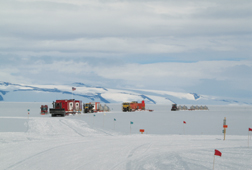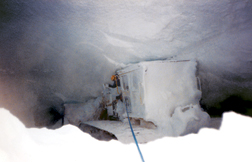 Traverse Crew, USAP/NSF Tearing down a drive track for a bearing replacement on the Leverett Glacier.
|
Brian Wheater had no hint of the luck he was about to have as he rumbled across Antarctica’s Ross Ice Shelf in November 1990 on Linda, a Caterpillar D8 LGP bulldozer. He was in the middle of a three-machine convoy dragging a huge sled of gear toward the foot of a glacier for a round of seismic testing. The machines tracked a few hundred feet apart. Hills and troughs regularly hid them from each other as they traced a route declared safe by visual inspection from a C-130 days before. “It was like rollers on a lazy ocean,” Wheater recalls. He didn’t know it at the time, but that was a huge warning sign.
|
Wheater and Quintin Rhoton, at the dozer’s controls, were in the heated, glazed cab when suddenly the world exploded. The 140,000-lb dozer vanished through an 8-ft-thick cap of snow spanning a huge crevasse. It smashed through the snowbridge. The windows imploded and snow and ice rammed inside. “It entombed us,” Wheaton says. They would have been dead, but for a stroke of luck.
“It happened so fast and the Cat is so big there was no sensation of falling,” Wheater says, but as they launched into blade-first freefall it ended in a jerk that sent the contents of the cab vomiting through the windshield. Wheater and Rhoton had the good fortune to smash into the dashboard and tangle up in the thicket of controls and levers. The Cat’s fall into the 300-ft-deep crevasse had been arrested by the trailing sled and its load of 30,000 lb of dynamite.
“The sled went clear across and wedged into the other side of the crevasse,” Wheater says. The towbar hung the Cat by its tail.
 George Blaisdell, USAP/NSF |
 Brian Wheater Waters, bottom, signals rescue team from hanging dozer cab during rescue of Wheater and Rhoton from crevasse in 1990; Year-4 "Proof of Concept" convoy returns triumphantly to McMurdo Station from 2,000-mile traverse to South Pole in 2006.
|
Fortunately, they had gone in near the head of the crevasse, just before it really widened. “It was enormous. If we had been 20 or 30 feet to the left the sled would have gone right in and we would have still been falling,” Wheater says. On the other hand, “The walls were beautiful, like mirrors,” he says. They went from light blue to medium blue, to dark blue, to the abyss. “It’s black. There is no way to get out of one if you go in.”
The men had sprains and bruises but no broken bones. They also had about 15 minutes to try and climb up the wreckage before the hot machine frosted over and became too slick to climb. Wheater says Rhoton couldn’t manage the climb so they sat and watched the dozer turn white. On the surface, the rest of the convoy was frozen in place, afraid to budge. Wheater now knows what the rolling terrain means. “You’re in a crevasse field and by the time you see it, it’s too late,” he says.
Three hours passed and then Wheater heard a woman’s voice saying help was on the way. It was Maryanne Waters, head of a New Zealand search and rescue team based at McMurdo Station. She was rappelling in to save them.
 John Wright,& Jessica Walker, USAP/NSF |
A lot has changed since then. On Feb. 7, at 18:30 hours McMurdo-time, a seven-machine convoy of blade-equipped Case International STX 450 Quadtrack tractors and Caterpillar-AECO MT-865s, led by a Kässbohrer Pisten Bully scout vehicle with a boom-mounted ground penetrating radar sliding ahead, dragged a train of huge cargo sleds safely into McMurdo Station. They were returning from a 2,064-mile traverse to the South Pole and back. It was only the second time in history such a feat had been accomplished, and it marks the first “production run” of a dream to find a safe haul route between the port at McMurdo Station and the research station at South Pole. The only other cargo link is by LC-130 aircraft, whose capacity is very limited and hugely expensive.
The traverse followed the path of a successful proof-of-concept project that quietly concluded its first cargo-hauling round-trip in January 2006, culminating decades of icecap science, steady advances in development of exotic remote sensing technologies and four years of painstaking route-proofing, equipment trials, crevasse-bridging and courageous exploration.
The Mission
The prime support contractor for the National Science Foundation’s United States Antarctic Program is Raytheon Polar Services, Centennial, Colo. In 2002 Raytheon asked geologist and explosives engineer John Wright to serve as project manager on the traverse project.
As he considered, Wright turned to his friend, Brian Wheater, to ask about “institutional, programmatic and expeditionary influences” that contributed to Wheater’s near death with Linda a decade before. Wright thought the answers revealed a prevailing blasé attitude about the dangers. He vowed any...
 Related Links:
Related Links: 


Post a comment to this article
Report Abusive Comment